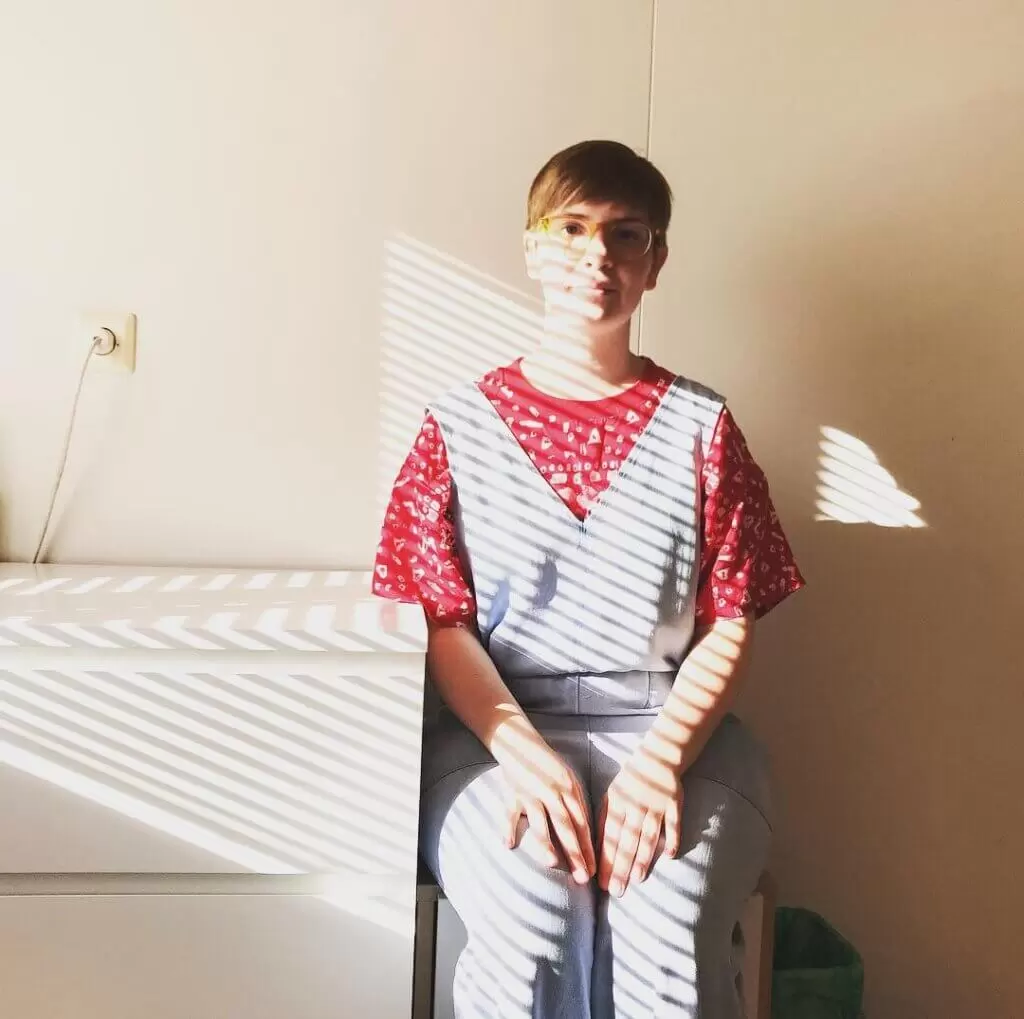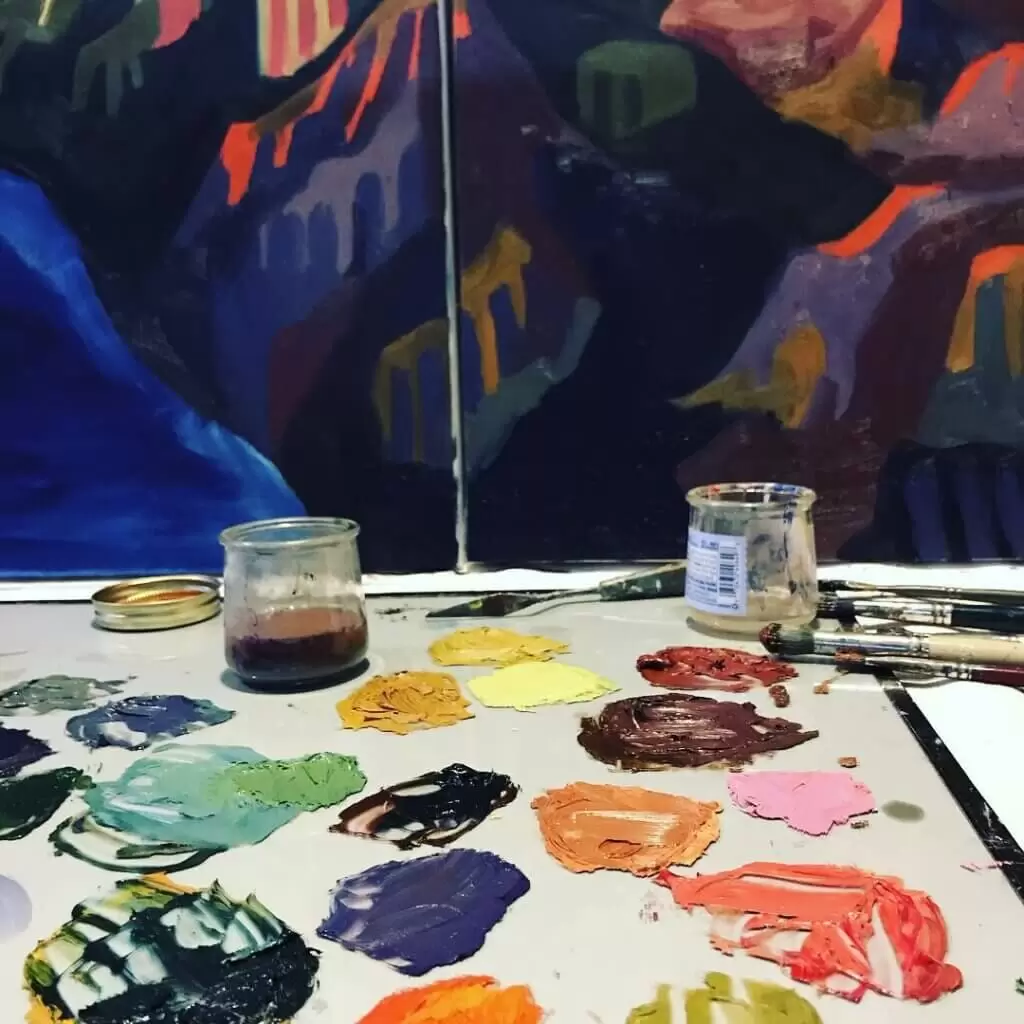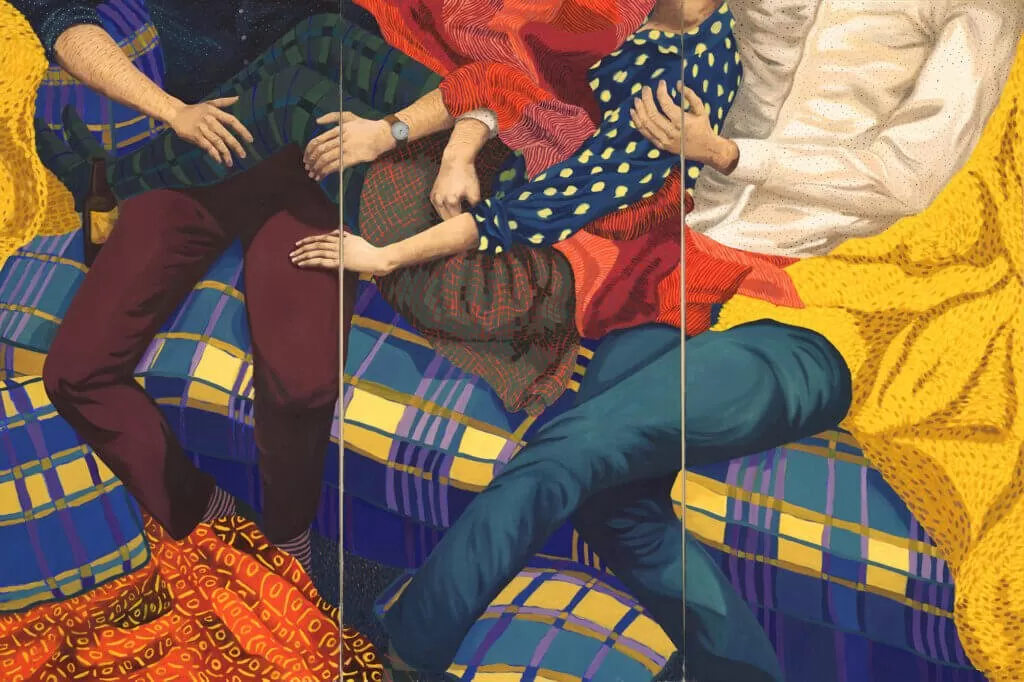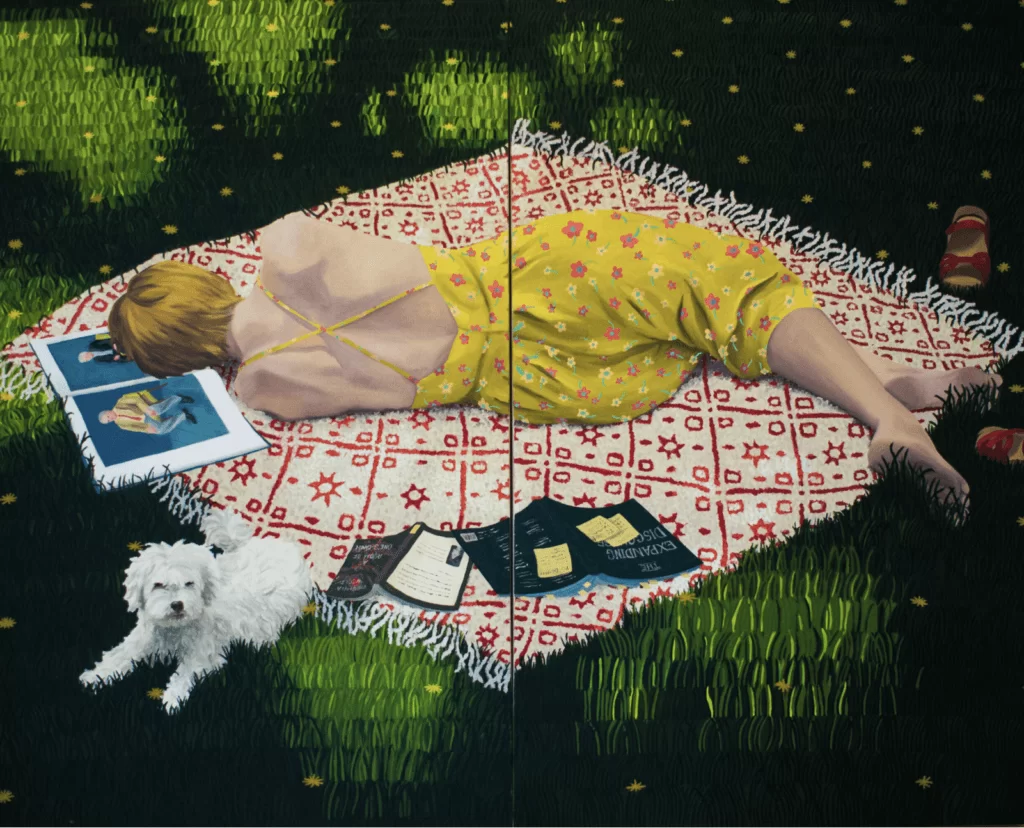Seattle-based artist Anna Teiche uses oil paintings to depict fragmented figures enmeshed in vivid textiles. Often piecing together images from photographs of her subjects, Teiche pays special attention to the nuances of their personalities, focusing less on their faces—which are inherently expressive—and more on the aspects of patchworked figures draped in rich, warm fabrics and thus seemingly disjointed. Though their faces are unseen, Teiche’s paintings of them evokes such an intimacy, in their relationships with each other and with the artist herself, that we, in turn feel as if we know them intimately.

My creative process often begins with walking and observing. I find myself photographing moments I see from my surroundings, and from there extrapolating paintings and series out of those.
Anna Teiche
Interestingly, Teiche calls on artists like Ellsworth Kelly, using similar geometric laser-focused, light-dashed motifs and turning them into fluid pieces. That is perhaps why her work is so visually interesting: it has us teetering in and out of focus, from the deeply personal nature of her figures’ body language to a collective thread of dynamic, bright portraits. Inviting in nature, we’re drawn into her paintings’ flicks of color and the oscillating movement within them, only to realize their complexity upon closer analysis. It leaves us wondering: What gets lost in the submersion? Who or what emerges from these pieces?
Find Teiche’s work at the Bainbridge Island Museum of Art, where her exhibition, Anna Teiche: Fragments has been extended for viewing until September 27, 2020.
Q: What does your creative process look like? Where does it begin for you?
Anna Teiche: My creative process often begins with walking and observing. I find myself photographing moments I see from my surroundings, and from there extrapolating paintings and series out of those. In my figurative work many pieces begin with a piece of clothing someone is wearing, and from there I ask them if they would be interested in sitting for a painting.

I then go to their home or a space they felt comfortable in, and borrow fabrics and pieces of clothing to stage the image, then take a bunch of photographs from every angle and detail, that I later piece together into a full painting.
Q: What are your preferred mediums?
Anna Teiche: My work mainly focuses on oil painting with some experimentation in fiber arts. I’m interested in the intersections between painting and the physical process of creating a “textile” of sorts through painting on canvas, combining this with more traditional fiber techniques like weaving and embroidery. While traveling I often work in smaller scale gouache painting as well, mainly for sketching and documenting the beginnings of ideas.


Q: Who are the subjects in your paintings? Why do you choose to include them in your work?
Anna Teiche: Many of the subjects in my work are friends and family. I like to work with people I know well. I think painting is often a very solitary act, and I originally began painting figures as a way of inviting people into my work and space. Photographing and painting people became a way for me to get to know them on a different level, and to collaborate with people from many different backgrounds. As I continued with this series I began to notice how the personality of each sitter became a driving factor in how the paintings would develop, the compositions and colors and poses all feel deeply influenced by the sitters the more I work on each painting.
I have found a certain tension in painting people that I know as well, in how much control is given to the sitter, versus how much control I take in choosing how to depict them, and what the image focuses and conveys to a viewer about the sitter.

I rarely include faces in my work, partially because I’m interested more in the complicated intersections in personality, and partially because I like the anonymity of each person. Faces give so much information away so quickly, I instead want to make a viewer “digest” the image over time, and discover the human element in the abstraction of patterns and textiles that are meaningful to the person painted, rather than first identifying a face and body before considering the items and patterns surrounding them.
Q: How do bodies, textiles, and space figure in your work?
Anna Teiche: I have always felt drawn to pattern and repetition, and actually grew up doing a lot of sewing and embroidery projects as a kid. I never really intended for my work to focus so much on fiber arts, but while painting one of the first portraits I ever did in college I found myself so drawn to painting the fabric texture on the couch around the figure, that I knew I had to follow that feeling of obsession and excitement.
I’m interested in the intersections of realism and abstraction as well. In working with realistically painted figures and folds of textiles, keeping such a shallow depth of focus is a way to avoid the expectation of a traditional portrait, and instead to invite a reference to Modernism and abstraction, and the reductive geometric, and often repetitive qualities of painters like Ellsworth Kelly.

Q: How do you know when a piece is finished?
Anna Teiche: Honestly, part of it just becomes feeling like I’ve gotten as much out of the painting as I will. On the other hand, I could probably identify parts of almost all my paintings that could still use work, and parts to change if I were to do it again. Each painting for me feels like a way of process an idea I have though, and once that idea has been processed I don’t necessarily find it useful to keep working and reworking an image.
Q: Which of your works resonate the most with you? Do you have a favourite piece?
Anna Teiche: At the moment “Picnic on the Lawn” is a piece I’m creating an ongoing series loosely inspired by. Outside of my painting practice I work at a botanical garden.
I have become fascinated by how patterns and texture in nature can be manipulated to feel orderly, almost textile-like in how people control their growth. It’s one of those ideas I can’t get out of my head until I make some more paintings out of it, and this painting really started off that path of exploration.

Q: How have your residencies and first solo exhibition inspired you or energized your practice?
Anna Teiche: The residencies I did in 2019 have been hugely influential to my work. I went into them very quickly after graduating from my undergraduate degree, and didn’t really have a huge plan or idea of what to expect, but knew I wanted to travel and to spend time being an artist outside of the more structured academic setting of my education. I ended up attending four residencies over the course of the year—in remote Iceland, along the Baltic coast of Lithuania, in Budapest, Hungary, and then back in my home state of Washington.

They were each so inspiring, meeting artists and creators from all over the world, who have all taken such different paths into the wider arts community. It definitely opened my eyes to so many more possibilities and routes. The friendships I found at each place have been so meaningful, and being able to work so closely with other artists and be constantly discussing and trading ideas was so exciting and invigorating for my work.
I was also struck by how much my work felt influenced by the location I was in. Once I had returned from my last residency I looked through all the work I had made over the year, and was shocked by how much of each location and my impression of each culture manifested itself in the works, yet kept a common thread through my interests in figuration and pattern. Having my first solo show open soon after I returned, in March of this year, felt a bit like the closing sentence of my current series, and in a way has allowed me to begin branching out past my figurative textile paintings and exploring new intersections in my interests.
Q: What is the most rewarding aspect of being an artist?
Anna Teiche: Part of it is the feeling of deep focus that I get when I’m really into a painting. It is a very peaceful feeling, and I often don’t notice how quickly time passes when I’m painting. The other aspect is the art community, and the feeling of meeting and spending time with people who just get each other a deeper level, who get the compulsion to make and process and combine ideas.

Q: What are the most challenging aspects?
Anna Teiche: The business side of managing sales, shows, and all the stuff that goes into being an artist outside of the actually thinking about and making work. And the wider uncertainty of the artist lifestyle, though exciting in many ways, can also be pretty anxiety inducing. Managing all the “work” stuff is what I feel like I’m always trying to get done with so I can get back to painting.
Q: What advice would you give emerging artists?
Anna Teiche: As an emerging artist myself I don’t know how helpful this is, but for me it’s actually advice one of my professors gave me, which is to find a small core group of people who will give you honest feedback, and who are open and excited to discuss your work with you. It’s helped me grow the most to have discussions with other artists and creators I admire, and to be able to “play” and experiment with different ideas, often inspired by discussion with other artists.
This was Anna Teiche In Dialogue With Hind Berji
https://www.instagram.com/annateiche/
©2020 Anna Teiche, Isabella Hin





